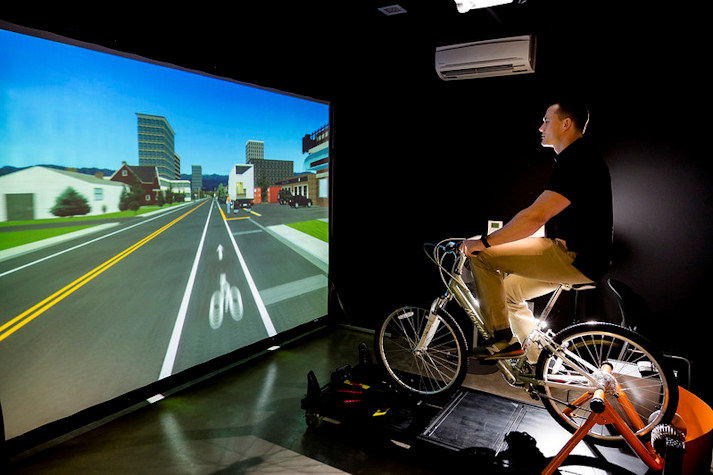Bicycle ‘rolling stop’ laws don’t lead to unsafe behavior by riders or motorists, OSU research shows

CORVALLIS, Ore. (KTVZ) – Laws that let bicyclists treat stop signs as yield signs lead neither riders nor motorists to act unsafely, according to a groundbreaking Oregon State University study.
The project by OSU College of Engineering researchers featured a novel experimental technique – linking separate bicycle and motor vehicle simulators – and the findings are important as more and more states consider bicycle rolling-stop legislation, said David Hurwitz, the study’s leader.
“It required fully connecting two independent simulators, running subjects in pairs simultaneously and having each subject interacting with an avatar of the other in a shared virtual world,” said Hurwitz, a transportation engineering professor. “We evaluated safety-relevant behaviors associated with laws stemming from the ‘Idaho stop,’ which was put on the books in 1982 but largely ignored around the country until not long ago.”
Starting in 2017, seven states have followed Idaho’s lead and enacted bicycle rolling-stop laws, including Oregon in 2019 and Washington in 2020. The others are Arkansas, Delaware, North Dakota, Oklahoma and Utah, and several additional states have considered legislation.
The laws vary in their specifics, but the basic idea is that cyclists are allowed to treat static stop signs as yield signs. The primary reason supporters like the laws is that they allow riders to keep their momentum, theoretically reducing intersection congestion and crash risk because the cyclists are getting through the intersection faster.
Nearly half of all bicycle-car crashes happen at intersections, Hurwitz said. In 2022, the latest year for which numbers are available, 1,105 bicyclists in the United States were killed in collisions with motor vehicles, according to the National Highway Traffic Safety Administration – a 13% increase from the 976 killed in 2021.
“The focus of previous research has been crash-data analysis and why riders are motivated to do a rolling stop, even when it’s illegal in their state,” he said. “No one has looked at how well bicycle rolling-stop laws work, or what happens when you educate people about them. Our networked simulator study design let us evaluate driver and rider behavior and their understanding of the law.”
The study, which included Gonzaga University’s Rhonda Young, an OSU graduate, and the University of Idaho’s Kevin Chang, involved 60 people observed in pairs as they went through 16 “live-interaction” scenarios related to a bicyclist and motorist coming together at a four-way, stop-controlled intersection.
Previous research has indicated that drivers tend to be more aggressive toward cyclists when they think riders are breaking the law, Hurwitz said. In this study, time-space diagrams showed that after receiving education about the rolling-stop law, bicyclists preferred to yield rather than stop and went through intersections faster. Driving participants, meanwhile, approached intersections either more slowly or at a similar speed after being educated about the law.
“The findings suggest more outreach in regard to rolling-stop laws would be useful, and this research gives decision-makers information to support prospective legislative policies, set up educational programs and design robust enforcement practices,” Hurwitz said.
That’s particularly important in places like the Pacific Northwest, he added, noting Oregon and Washington have two of the largest percentages of bicycle commuters in the country. About 2% of Oregon workers get to their job via bicycle, and just under 1% of Washington workers.
The League of American Bicyclists’ 2017 Report on American Community Survey shows Portland with the second-largest number of bicycle commuters in the United States, ranking behind only New York City. There are about 22,000 bicycle commuters in Portland, and about 17,000 in Seattle.
OSU’s Jasmin Woodside, a master’s student and professional engineer, and Hisham Jashami, an assistant professor, also contributed to the study, which was funded by the U.S. Department of Transportation’s University Transportation Center Program and published in Transportation Research Part C.